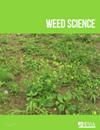窄行距是否能抑制杂草并提高玉米和大豆的产量?一个荟萃分析
IF 2.5
2区 农林科学
Q2 AGRONOMY
引用次数: 0
摘要
窄行距(76 cm)可以提高作物竞争力,抑制杂草,并可能提供产量优势。已经进行了许多研究来评估窄行距的影响;然而,目前还没有对这些研究进行定量综合。本荟萃分析的目的是:(1)量化窄行距(<76 cm)对玉米(Zea mays L.)和大豆(Glycine max (L.))杂草密度、生物量、防治、杂草种子产量和产量的总体影响。稳定。(2)评估农艺管理决策(耕作方式、杂草管理、除草剂使用频率和时间)对窄行距杂草抑制效果和玉米、大豆产量的影响。我们从1961年至2018年在美国12个州进行的35项研究中收集了1904项成对观察结果。平均而言,与76厘米行距相比,窄行距对杂草密度、生物量和种子产量的抑制分别为34%、55%和45%,而对杂草的控制效果分别为32%和11%。与76 cm行距相比,窄行距大豆杂草密度降低42%,杂草生物量降低71%,作物产量提高12%。虽然窄行距对玉米响应变量的影响不显著,但针对每个响应变量的研究(n = 1 ~ 6)和观察(n = 1 ~ 59)数量有限。在窄行距条件下,常规和减量耕作方式对杂草密度、防治措施和种子产量的响应无显著影响;但与单次施用相比,连续施用除草剂对杂草生物量和种子产量的影响更大。因此,大豆的窄行距可以与其他抗除草剂杂草管理方案相结合。本文章由计算机程序翻译,如有差异,请以英文原文为准。
Does narrow row spacing suppress weeds and increase yields in corn and soybean? A meta-analysis
Abstract Narrow row spacing (<76 cm) could improve crop competitiveness, suppress weeds and might provide yield advantage. Many studies have been conducted to evaluate the impact of narrow row spacing; however, no quantitative synthesis of these studies exists. The objectives of this meta-analysis were to (1) quantify the overall effect of narrow row spacing (<76 cm) on weed density, biomass, control, weed seed production, and yield in corn ( Zea mays L.) and soybean [ Glycine max (L.) Merr.] compared with 76-cm row spacing, and (2) assess the influence of agronomic management decisions (tillage type, weed management, herbicide application frequency and time) on effect of narrow row spacing on weed suppression and corn and soybean yield. We compiled 1,904 pair-wise observations from 35 studies conducted in 12 states in the United States during 1961 to 2018. Averaged across individual observations, narrow row spacing suppressed weed density by 34%, weed biomass by 55%, and weed seed production by 45%, while it improved weed control by 32% and crop yield by 11% compared with 76-cm row spacing. Narrow row spacing in soybean suppressed weed density by 42%, weed biomass by 71%, and increased crop yield by 12% compared with 76-cm row spacing. Although narrow row spacing had a nonsignificant effect on response variables in corn, the number of studies ( n = 1 to 6) and observations ( n = 1 to 59) addressing each response variable were limited. Tillage type (conventional and reduced) did not influence the response of weed density, control, and seed production in narrow row spacing; however, weed biomass and weed seed production were more greatly reduced with the sequential application of herbicides compared with a single application. Thus, narrow row spacing in soybean can be integrated with other options for management of herbicide-resistant weeds.
求助全文
通过发布文献求助,成功后即可免费获取论文全文。
去求助
来源期刊

Weed Science
农林科学-农艺学
CiteScore
4.60
自引率
12.00%
发文量
64
审稿时长
12-24 weeks
期刊介绍:
Weed Science publishes original research and scholarship in the form of peer-reviewed articles focused on fundamental research directly related to all aspects of weed science in agricultural systems. Topics for Weed Science include:
- the biology and ecology of weeds in agricultural, forestry, aquatic, turf, recreational, rights-of-way and other settings, genetics of weeds
- herbicide resistance, chemistry, biochemistry, physiology and molecular action of herbicides and plant growth regulators used to manage undesirable vegetation
- ecology of cropping and other agricultural systems as they relate to weed management
- biological and ecological aspects of weed control tools including biological agents, and herbicide resistant crops
- effect of weed management on soil, air and water.
 求助内容:
求助内容: 应助结果提醒方式:
应助结果提醒方式:


